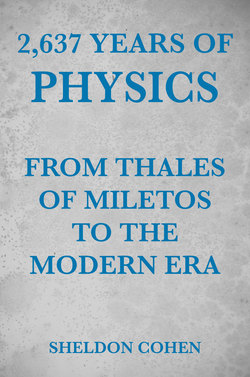2,637 Years of Physics from Thales of Miletos to the Modern Era

Реклама. ООО «ЛитРес», ИНН: 7719571260.
Оглавление
Sheldon Cohen. 2,637 Years of Physics from Thales of Miletos to the Modern Era
THE FIRST THOUGHT EXPERIMENT: IS THERE A PRIMORDIAL BUILDING BLOCK?
Thales of Miletos (624-546 BCE)
Theophrastus (371-286 BCE)
Anaximander (610-546 BCE)
Anaximenes (570-528 BCE)
Heraclitus of Ephesus (533-475 BCE)
Empodocles of Sicily (fifth century BCE)
Anaxagoras (500-428 BCE)
Leucippus (490-? BCE)
Democritus (460-370 BCE)
Aristotle (384-322 BCE)
Epicurus (341-270 BCE)
Lucretius (96-? BCE)
Pierre Gassendi (1592-1655)
WHAT IS LIGHT?
Pythagoras (582-500BCE)
THERE ARE ATOMS AFTER ALL. Boyle (1627-1691)
Descartes (1596-1650)
Galileo (1564-1642)
Back to Boyle
Joseph Louis Proust (1754-1826)
The French chemist… Claude Berthollet (1748-1822)
John Dalton (1766-1844)
William Nicholson (1753-1815)
Jons Jacob Berzelius (1799-1848)
Dmitri Ivanovich Mendeleev (1834-1907)
ATOMS ELEMENTS COMPOUNDS
WHAT IS THIS ATTRACTIVE FORCE?
Charles Francois Dufay (1698-1739)
Pieter van Musschenbroek (1692-1761)
Leyden jar
Benjamin Franklin (1706-1790)
Luigi Galvani (1737-1798),
Alessandro Volta (1745-1827)
Anthony Carlisle (1768-1840),
Joseph Priestly (1733-1804)
Petrus Peregrinus (1220-?)
William Gilbert (1544-1603)
BEAUTIFUL LIGHTS. FORCES OF ATTRACTION AND REPULSION. MYSTERIOUS RAYS
Vincenzo Cascariolo (1571-1624)
Otto von Guericke (1602-1686)
Stephen Gray (1666-1736)
Charles Coulomb (1736-1806)
Hans Christian Oersted (1777-1851),
Dominique Francoise Arago (1786-1853),
Andre Marie Ampere (1775-1836)
Michael Faraday (1791-1867)
James Clerk Maxwell (1831-1874),
Heinrich Geissler (1815-1879)
Julius Plucker (1781-1840)
Johann Wilhelm Hittorf (1824-1914)
Hittorf and Plucker
Eugen Goldstein (1850-1930),
William Crookes (1832-1919)
Albert Michelson (1853-1931) Edward Morley (1838-1923)
Heinrich Daniel Ruhmkorff (1803-1877)
Heinrich Hertz (1857-1894),
Guglielmo Marconi (1874-1937)
Phillip Lenard (1863-1947)
THE FIRST LOOK INSIDE THE ATOM…X RAYS
Wilhelm Konrad Roentgen (1845-1923),
A FURTHER LOOK INSIDE THE ATOM…RADIOACTIVITY. Antoine Henri Becquerel (1852-1908)
Marie Curie (1867-1934)
Pierre Curie (1859-1906)
BACK TO LIGHT
Thomas Young (1773-1829)
THE UNIVERSE IN MOTION
Aristotle (384-322 BCE)
Ptolemy (100-178)
Copernicus (1473-1543)
Johannes Kepler (1571-1630)
Tycho Brahe (1546-1601),
Gallileo Galilei (1564-1642)
Isaac Newton (1642-1727)
Galilei Galileo (1564-1642)
Olaus Roemer, (1644-1710),
Jean Dominique Cassini (1625-1712)
James Bradley (1697-1712)
Christian Huygens (1629-1695)
THE SPECTRUM: AN INDIRECT PEEK INSIDE THE ATOM
Georgius Agricola (1494-1555)
Joseph von Fraunhofer (1767-1826)
Gustav Kirchoff, (1824-1887)
Robert Bunsen (1811-1899)
ANOTHER PEEK INSIDE THE ATOM---THE ELECTRON---WHAT DOES AN ATOM LOOK LIKE? Joseph John Thomson (1826-1911)
G. Johnstone Stoney (1826-1911)
A BETTER VIEW OF THE ATOM
Ernest Rutherford (1871-1937)
OPEN THE DOOR TO A NEW PHYSICS. Max Planck (1858-1947)
James Jean (1877-1946)
Wilhelm Carl Wien (1864-1928)
Albert Einstein (1879-1955)
Robert A. Milliken (1868-1953)
Johan Jacob Balmer (1825-1898)
Johannes Rydberg (1854-1919)
Thomas Rees Wilson (1869-1959),
A NEW ATOM. THE START OF QUANTUM MECHANICS. Neils Bohr (1885-1962)
Gustav Ludwig Hertz (1892-1985)
A NEW GRAVITY
BACK TO THE ATOM
Arnold Sommerfeld (1868-1951)
Pieter Zeeman (1865-1943)
Arthur Holly Compton (1892-1962)
Wolfgang Pauli (1900-1958)
PARTICLE AND WAVE. Louis De Broglie (1892-1987)
Paul Langevin (1872-1946)
Germer (1896-1971)
IT’S FUZZY DOWN THERE. Werner Heisenberg (1901-76)
Max Born, (1882-1970)
Pascual Jordan (1902-1980)
Erwin Schrodinger (1887-1961)
Paul Dirac (1902-1984)
Carl Anderson (1905-1991)
THE NUCLEAR AGE: PROMISE OR DISASTER?
James Chadwick (1891-1974)
Hideki Yukawa (1907-1981)
George Gamow (1904-1958)
Enrico Fermi (1901-1954)
Otto Hahn (1879-1968)
Fritz Strassman (1902-1980)
Lisa Meitner (1879-1968)
Otto Frisch (1901-1979)
Leo Szilard (1898-1964)
J. Robert Oppenheimer (1904-1967)
General Groves (1896-1970)
END GAME
WHAT HAPPENED TO AIR, EARTH, FIRE AND WATER? HOW THE UNIVERSE WORKS. SUBATOMIC PARTICLES
Ernest Rutherford, in 1911
HISTORY OF THE UNIVERSE
Edwin Hubble (1889-1953)
Robert Wilson (1927-2002
BIBLIOGRAPHY
Отрывок из книги
The author, Sheldon Cohen, is a retired physician with a lifetime fascination of Physics.
So, why not write a book?
.....
suggested that rather than one basic element there were four: air, fire, earth, and water. These basic four elements, mixed and partially combined and separated, thus resulting in the various familiar forms of matter.
In the future, philosophers who adopted the primary building block theory suggested that the four basic elements of air, fire, earth, and water were each made of different atoms. This somewhat brought the atomos concept back into thought. Even with only four basic building blocks, the various combinations of these could result in a great variety of different forms of matter. If the proportions of the building blocks remained the same, there were twenty-four different combinations. Now consider the infinite number of combinations that would occur if you varied the amounts of each of the four basic elements.
.....